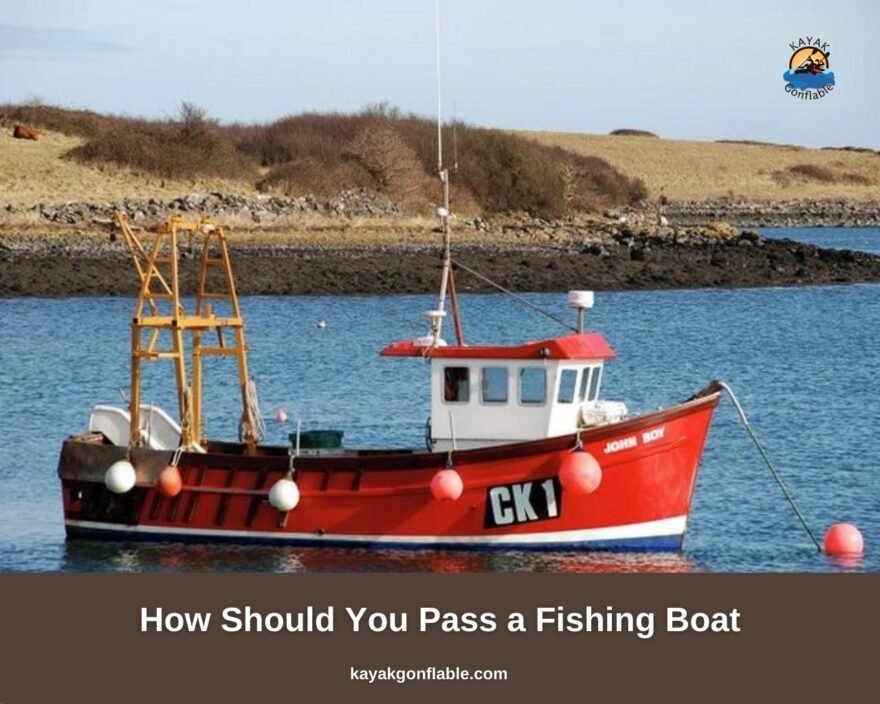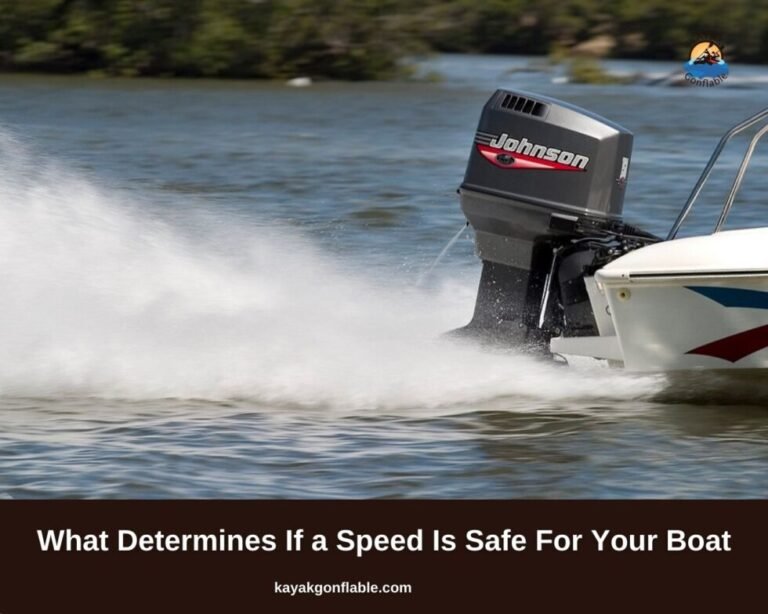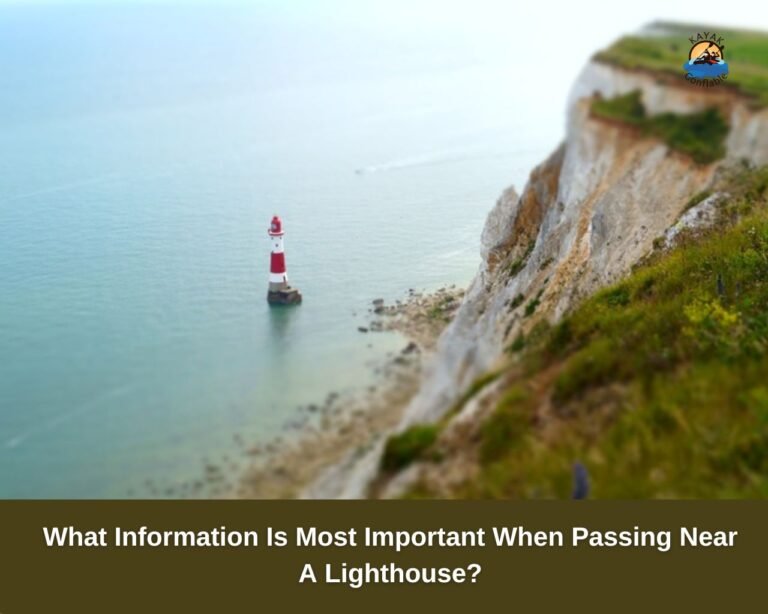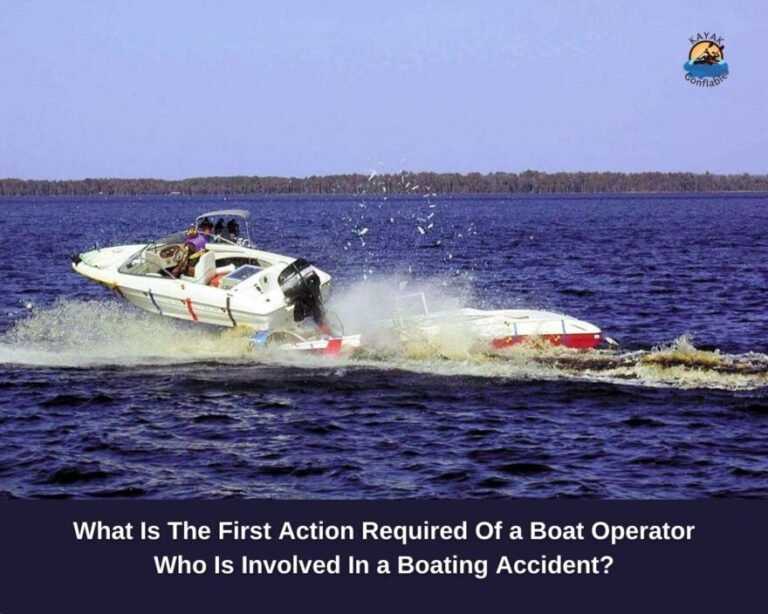How Should You Pass a Fishing Boat?

Once you pick up boating, seeing fishing boats becomes a common occurrence. One could even argue that it sharpens your fishing boat sensors (assuming said sensors exist LOL). Jokes aside, the chances of you meeting a fishing boat while on the water are very high.
Fishing boats are ubiquitous in coastal waters and can be found around nearly every body of water. So, what’s the best way to pass one? Passing a fishing boat can be a dangerous proposition if not undertaken carefully.
If you’re ever in the position of passing a fishing boat, there are a few things you should keep in mind to ensure the safety of everyone in the water. In this article, we disclose tips on how you can safely pass a fishing boat when boating. Let’s dive in.
Getting Around a Fishing Boat
Fishing boats are a common sight on the open water, but passing one can be tricky. Here are some tips to help you safely pass a fishing boat.
- First, always check to make sure the boat is aware of your presence. Many fishermen use radios to communicate with one another, so they may not have seen you yet. If there is no response from the boat, or if they are signalling for you to go around them, use caution when passing and give them plenty of room.
- Make sure there is enough water between your boat and the fishing boat to avoid any contact.
- Finally, keep an eye on the fishermen and their gear. They may be casting their lines and don’t want them tangled up in your propeller.
When Passing a Fishing Boat:
1. Maintain a safe distance
When you are out on the open water fishing, it is important to remember to give other boats plenty of room. If you see a boat coming towards you, be sure to give them space to pass.
Do not cut in front of them or try to pass them on the right side. Doing so can cause accidents and injuries. Remember to always use common sense and be safe while fishing.
If there are waves, try to go over them instead of through them. Remember, giving the other boat the space they need to manoeuvre brings safety.
2. Adjust your speed
If you are on a fishing boat and see another boat coming toward you, the best course of action is to slow down and let them pass. In a situation where the other boat does not slow down, do whatever you can to get out of its way.
Do not attempt to cross its path; this could lead to serious injury or worse. In some cases, it may be necessary to use your engines to try and get past the other boat.
3. Do not make any sudden moves.
Making a sudden move when passing another boat will startle the other fisherman and cause unnecessary accidents. While passing another boat, don’t touch or bump into it.
You should not wave at boats to get their attention. Driving your boat in the same direction as a sailboat is a very bad idea. Do not point your boat at another boat’s bow. Do not try to get close to another boat.
Using your radio or cell phone while on the water can cause a disturbance and may scare fish away. Finally, be aware of other boats’ wakes and waves.
4. Passing on the left side when passing another boat
When two boats approach each other while sailing, the boat on the right is supposed to yield to the boat on the left. This is called Right of Way.
However, there are times when it is safer for a boat to pass on the left side instead of the right. Sailing on the left side also gives you a better view of what is ahead and allows you to avoid any potential hazards.
It is very important to always use common sense and assess each situation before deciding which side to pass on. One reason to pass on the left side is when there is a large vessel in front of you and it would be difficult to get by on the right.
Another reason is when there are obstacles in the water that would make it difficult to pass on the right, such as large rocks or islands.
5. Using your horn
When you are driving a boat, it is important to use your horn to signal your passage to other boats. This ensures that both boats know what is happening and can avoid any potential accidents.
There are a few different ways to use your horn when passing, so make sure you are familiar with them before you go out on the water. One way to use your horn when passing is to give a short blast as you approach the other boat.
This will let the other driver know that you are there and that they need to move over. Another way to use your horn is to give a long blast as you pass the other boat. This will let the driver know that you have passed them and that they can resume their course.
Be sure to use your horn sparingly, as too many blasts can be annoying and may even lead to a confrontation.
6. Watching for fishing lines
When sailing close to another boat, it is important to watch for fishing lines. These thin plastic or metal cables can be stretched between boats, and can easily snag on a boat’s propellers or rigging.
If you see a fishing line, avoid getting too close, and stay clear until the line has been safely cut or broken. Do not approach the fishing line – instead, call out to the person on the other boat and warn them about the line.
7. Following local laws
When boating, it is important to adhere to local laws and regulations. One such law is the passing distance requirement. To avoid collisions, boats must pass each other at a safe distance.
The specific distance will vary depending on the location, but it is typically at least 100 feet. Boat operators should always use caution when passing, especially when there are other boats or obstructions in the area.
8. Use common sense and be courteous
When out on the open water, it is important to always use common sense and be courteous to other boaters. Make sure there is enough space to pass safely before you attempt to pass another boat.
If you are in a larger boat, slow down and give the smaller boat plenty of time to pass. Be aware of your surroundings and keep a lookout for other boats, especially when making turns.
Always follow the rules of the waterway and use caution when travelling at high speeds. Be aware of the boat’s blind spots and always try to pass other boats on the left side when possible. By using common sense and being courteous, we can all enjoy a safe and enjoyable day on the water.
In conclusion, when passing a fishing boat, be cautious and sensible. If you are on a larger boat, make sure to slow down and be cautious. If you are on a smaller boat, it is important to move to the side quickly and safely.
Always use caution when boating and be aware of your surroundings. Be sure to have a flag or horn to signal your presence.
Remember to be courteous and safe when sharing the water with fishermen. Following these tips will help you safely pass a fishing boat and avoid any potential accidents.
Frequently Asked Questions
What to do if a fishing boat is in your way?
If you are out fishing and come across a fishing boat that is in your way, there are a few things you can do to resolve the situation.
You can try to communicate with the boat’s captain and ask them to move, or you can try to manoeuvre around the boat. If those options don’t work, you can call the Coast Guard for help.
What to do if there is a fisherman in the boat you are trying to pass?
When encountering a fisherman in a small boat, it is important to take a few precautions. If possible, always try to pass the boat on the opposite side of the fishing line. If this is not possible, or if passing would create other hazards, slowly and carefully pass by.
Do not make sudden movements or loud noises, as these could startle the fisherman and cause them to lose their balance. Always give them plenty of room, and if they wave you on, go ahead and proceed.
What to do if a fisherman waves you down when you try to pass his boat?
If you are out on a boat and see someone fishing, it is polite to slow down or stop when they wave you down. Sometimes these fishermen are looking for help with their lines or bait, but other times they just want to chat.
No matter what the reason, it is always good to be respectful and take a moment to speak with the fisherman. If you are in a hurry, you can just continue on your way.
However, if you are comfortable doling out some time to chat, it is perfectly fine to stop and talk for a few minutes or even an hour or two. No matter what you choose, please be cautious and aware of your surroundings. You should also stay vigilant to ensure your safety.
How to pass a boat at night?
There are a few things to remember when trying to pass a boat at night. First, make sure you have the right of way. If there is oncoming traffic, they should yield to you.
Second, use your navigation lights when passing. This will ensure that the other boat operators can see you. Finally, use common sense and be aware of your surroundings.
Make sure that the boat you are passing is actually a boat and not just a floating object, and avoid passing boats in tight quarters or near other hazards.
How should you pass a fishing boat that is speeding?
When you are piloting and encounter a fishing boat speeding in the opposite direction, what is the best way to pass it? Some drivers may be tempted to speed up and try to get around the boat as quickly as possible.
However, this is dangerous and can lead to a collision. Instead, drivers should take their time and use caution when passing a fishing boat. Here are some tips for safely passing a fishing boat:
- Make sure that there is plenty of room to pass. Do not try to pass the boat if there is not enough space.
- Signal before changing lanes so that the fishermen know that you are passing them.
- Slow down when you approach the boat and do not create any waves that could potentially overturn it. This will allow the fisherman time to react if they need to move their equipment or if they have someone in the water.
- Maintain a safe speed and do not exceed the speed limit.
- Be sure to use your horn when passing so that the fisherman knows you are there.
The best way to pass a speeding boat is to stay as far to the side as possible. When the boat is about to cross your path, make a quick U-turn and drive away. This will cause the boat to slow down and give you time to avoid it.
What should you do if you encounter a fishing boat while out in your vessel?
If you are out on a boat and encounter a fishing vessel, there are a few things you should do. First, try to stay calm and avoid any sudden movements.
Then, signal to the fishermen that you see them and ask if they need help. If they indicate that they do need help, offer to provide whatever assistance you can.
If the fishermen indicate that they do not need help, give them plenty of room and continue on your way. Remember to always use caution when approaching or passing a fishing vessel, as they may be moving in unpredictable ways.
Why should boaters slow down while passing recreational fishing boats?
Boaters should always slow down when passing any type of boat, but it is especially important to do so when passing by a recreational fishing boat. These boats are often smaller and slower than other types of boats, so they can easily be missed if a boater is going too fast.
Additionally, many fishermen are looking for fish and may not see or hear a boat coming until it is too late. Slowing down will help avoid accidents and ensure the safety of everyone on the water.
Why can’t boaters fish in harbours and marinas?
Boaters cannot fish in a harbour or marina because they are private property. As a boater, you have the right to be on public waters, but not private property.
If there is a sign that prohibits fishing in the area or if the property owner tells you to stop fishing, then obey those instructions.
When a sailboat overtakes a powerboat which vessel is the stand-on vessel?
When two vessels are travelling in the same direction and one is a sailboat, the sailboat is the stand-on vessel. The powerboat must give way to the sailboat.
This is because a sailboat can stop or change course much more quickly than a powerboat. Sailboats also have the right of way in narrow channels and when crossing paths with other vessels.
What is the purpose of a navigation lights system?
A navigation lights system is a critical piece of equipment for vessels travelling on the open sea. Its purpose is to warn other vessels of the boat’s course and location. There are several types of navigation lights, each with its specific purpose.
The most common type is the white masthead light, which is displayed on the top of the vessel’s mast. This light shows other vessels that the boat is underway and warns them to stay clear.
Other common types of navigation lights include the red and green sidelights, which are displayed on either side of the vessel, and the white stern light, which is displayed at the back of the boat.
According to the navigation rules, what is the give-way vessel’s responsibility?
A give-way vessel refers to a vessel that is designated to stand in the path of another vessel to allow the passage of both vessels. This designation is typically made by the Coast Guard or other maritime authorities.
The vessel that is designated as a give-way vessel should have enough displacement and speed to keep up with the other vessel and should be equipped with proper navigation equipment.
The give-way vessel is responsible for avoiding a collision, even if it means taking evasive action. The give-way vessel should maintain a safe course and speed and should avoid excessive alteration of course or speed.
If the give-way vessel cannot take the necessary action to avoid a collision, then it must issue a warning signal.
In what situation does the give-way vessel have a right to take evasive action? The give-way vessel should not take an evasive action unless it can do so safely. The give-way vessel should:
- avoid a collision by putting on speed and altering course if necessary, or
- avoid a collision by taking action to warn the other vessel that it intends to do so.
How to signal a fisherman on another boat?
One of the niceties of fishing is the etiquette fishermen extend to one another. When two fishermen are trolling for fish in close proximity, it’s customary for them to signal one another about any noteworthy activity.
There are a few ways to do this. The most common way is by flashing a bright light at the other boat. A fisherman can also use hand signals or sounds to communicate with the other angler.
Use a bright light to signal another vessel, as this is the easiest way for the other vessel to see you. If both boats are trolling in close proximity, it’s customary for them to flash a light at one another.
What action should be taken when nearing a bend in a narrow channel?
When piloting a vessel in a narrow channel, it is important to know the proper action to take when nearing a bend.
Approaching the bend too quickly can cause the vessel to run aground while approaching too slowly can cause the vessel to be swept into the bend and potentially collide with other vessels.
To safely navigate a bend in a narrow channel, pilots should first assess their position and speed relative to the bend. If they are approaching too quickly, they should reduce their speed by using the engine or sail power; if they are approaching too slowly, they should increase their speed using engine or sail power.
In either case, pilots should always keep an eye on their surroundings and be prepared to take corrective action if necessary.
What is the best way to pass a boat on a narrow waterway?
There are a few different things that you can do to safely pass a boat on a narrow waterway. First, make sure that you have plenty of room to pass. If there is not enough room, wait for the other boat to move over.
If they do not move over, then you may need to use an alternate route. Secondly, use caution when passing and make sure that you do not come too close to the other boat.
Finally, if there is a strong current, make sure that you take into account how it will affect your boat’s movement.
What is the best way to pass a boat in a foggy or stormy situation?
When you are out on the water, one of the most important things to remember is how to safely pass a boat. In a foggy or stormy situation, it is important to follow the right procedures to avoid any accidents.
First, make sure that you have a clear view of the other boat and that there is plenty of distance between the two boats. Signal to the other boat with your horn and wait for them to respond before you begin to pass.
Once both boats have acknowledged each other, slowly begin to pass on the left side of the other boat. Make sure that you keep an eye on them at all times and be prepared to take evasive action if necessary.
If you are ever in doubt about whether it is safe to pass a boat, it is always better to err on the side of caution and wait until conditions improve.






